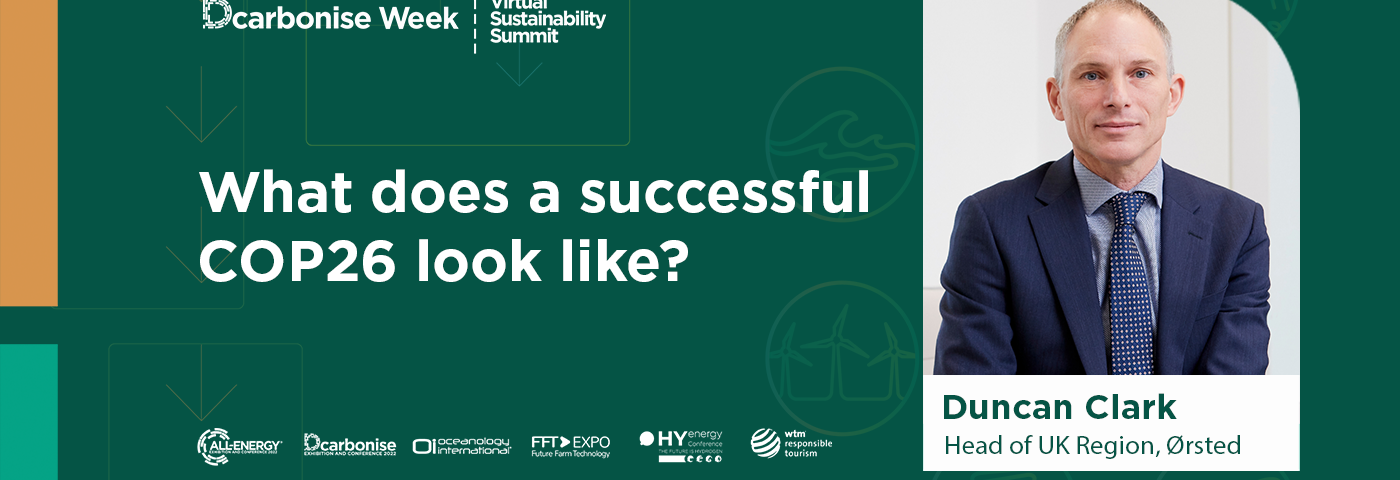Ahead of COP26, taking place in Glasgow in November, Duncan Clark Head of UK Region at Ørsted discusses what a successful outcome would look like.
What does a successful COP26 look like?
This November the United Nations, heads of governments, leaders of industry and civil society will come together in Glasgow at COP26 to agree actions to tackle climate change. This COP, or ‘Conference of the Parties’, is one of the key COPs that take place every five years where every country has to submit an updated carbon-reduction target and the actions it will take to reach that target, known as a ‘Nationally Determined Contribution’ or NDC.
Six years after the famous Paris COP of 2015, where all the countries present agreed to take action to keep global warming under 2 degrees and as close to 1.5 degrees as possible, the world will gather again to negotiate and agree on the actions they will take over the next five years and beyond to limit climate change. So what would a successful COP26 look like?
The first thing to note is that there will not be a single moment like there was in Paris when all the world agreed to act to limit climate change to as close to 1.5 degrees as possible. This time one of the key outcomes will be the individual commitments (Nationally Determined Contributions) that each country makes. Some countries such as the UK, Argentina, the EU 27 and the USA, have already made these commitments. Other countries will make them just before or at COP26.
There will, however, be a series of other outcomes that we can hope will come from COP26.
Firstly, the UK and many other countries are negotiating to secure 100 billion dollars per year to support developing nations in their journeys to net zero. Secondly, negotiators at COP are concentrating their efforts on the phasing out of coal use across the globe, as one of the most impactful changes that any country can make to limit carbon emissions. Thirdly, the COP will negotiate the rules on carbon markets to allow carbon emission trading across countries. These technical set of rules – referred to as ‘Article 6’ – in the Paris agreement are the last remaining set of rules yet to be agreed from the Paris Agreement, and the United Nations will be keen for them to be finalised at this COP.
So, if a successful COP26 is conditional on countries making enhanced commitments about how they are going to reduce carbon emissions, how easy is it for countries to do this, and what are steps will they need to take?
What do countries need to do to reduce their carbon emissions?
At Ørsted we believe that the goal of building a net-zero-emissions society by 2050 is ambitious and challenging; but it is a goal that is entirely achievable. We know that the production and consumption of energy are currently responsible for 73% of man-made global greenhouse gas emissions, making it essential to immediately accelerate the transition to renewable forms of energy in order to reach net zero and combat climate change.
The good news is that in many parts of the world, renewable energy from wind and solar is now cheaper than energy created from fossil fuels. According to the International Energy Agency, all of the technologies needed for the necessary cuts in global emissions by 2030 already exist. And for mid-century targets, a McKinsey & Company analysis shows that over 85% of the necessary emissions reductions can be achieved with technologies that are either already mature or in their early adoption phase.
But if this is the case, why is renewable energy not growing even faster than it is now? One of the reasons is the substantial amount of investment needed to transition the whole globe to renewable energy – over 100 trillion dollars by some estimates. And this level of investment will need to come from the private sector, with Governments and business working together to create the frameworks to encourage investment in the rollout of renewable energy.
The successful decarbonisation we have seen so far, including in leading countries such as Scotland, has come when the Government has set clear targets and created policies to encourage investment in renewables. When Governments commit to strong, mandatory climate policies and renewable-energy targets they send a signal to investors and the market that the energy transition will be a priority both now and in the long term. This is why ambitious commitments such as those made by the Scottish Government to achieve net zero by 2045 and achieve 11GW of offshore wind by 2030 are so important, backed up by actions such as running the ScotWind leasing round.
To achieve these targets governments across the world will need to improve the availability, affordability, and predictability of space for wind and solar. The share of renewable electricity generation needs to grow eight times faster than the current rate in order to meet the goals of the Paris agreement. Every delay to the permitting and consent process puts more distance between us and a path to the 1.5°C target.
Governments must also ensure that renewable energy systems are both modern and futureproof. Wind and solar power projects get most of the media attention, but investments to improve and expand electricity grids within and between jurisdictions are equally important.
However, delivering renewable energy projects at scale must also be done in a way that ensures that the transition occurs in harmony with people and nature. To ensure that the benefits – such as the creation of good jobs – can be felt across all communities, early engagement and collaboration with local communities will be crucial.
Part of the answer on ensuring that the transition to a net zero world is fair is linked to the jobs that are created by green technologies and investment to tackle climate change such as retrofitting buildings to make them more energy efficient. But another important part of the answer, is making sure that energy intensive industries can adapt to become less carbon intensive whilst still employing their workers.
This includes industrial processes such as the manufacture of chemicals, glass, cement and steel and it also includes heavy goods transport. For these ‘hard-to-abate’ sectors – which account for around 20% of global emissions – renewable hydrogen and green fuels must be deployed at scale. Not only does this reduce emissions, but it ensures that these industries in Scotland and the UK can continue to operate sustainably. That is the importance of renewable hydrogen – it is an essential part of full industrial decarbonisation in 2050.
What this means for COP26
As world leaders and negotiators converge on Glasgow this November, everyone present – including governments, businesses, and individuals – must keep demanding more concrete climate action.
We all have a responsibility to keep each other on track. In the run-up to COP 26, we at Ørsted hope to see more countries adopt enhanced nationally determined contributions under the Paris accord and implement policies to enable immediate action for mitigation, adaptation, finance, and strengthened collaboration.
Thousands of businesses, investors, cities, and citizens around the world have given governments the green light to hasten the green transition. We know that a net-zero economy will bring many benefits. We have the technologies to get there. The investments we need are substantial but eminently manageable within the right frameworks. We need to go all in now.
I am hopeful that COP26 talks will result meaningful policy and milestones that lead to action on climate change. I am certain that we have the technologies, the know-how and the finance available to reach net zero by 2050 and we must choose to do so.
About Ørsted
Ørsted was once one of the most coal-intensive energy companies in Europe. Today, we’re the world’s most sustainable energy company, and a global leader in the transition to green energy. Our business transformation is a story of technological innovation, steep learning curves and difficult strategic choices that have led to long-term gains. We want to share what we’ve learnt, from our decision to move away from an unsustainable business model based on fossil fuels, to the action we took to build a truly green business – and the benefits and opportunities it’s created for us.
To find out more, visit our website Our Green Energy Transformation | Ørsted (orsted.co.uk)

